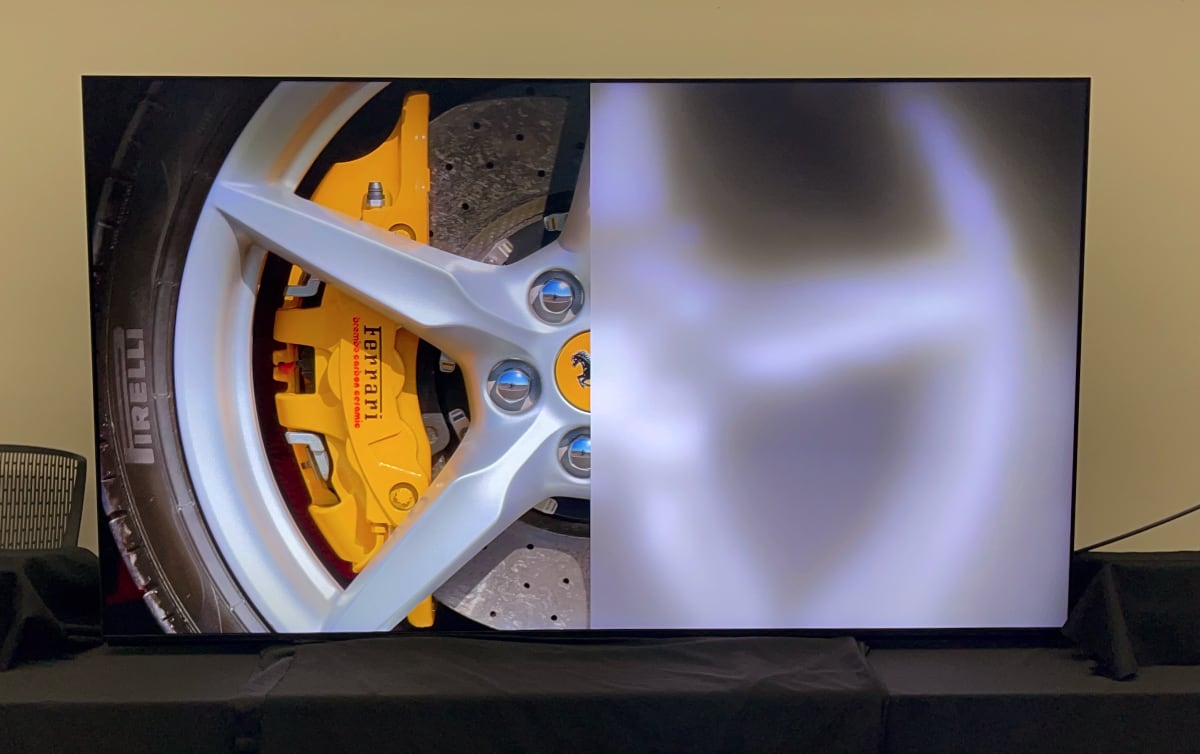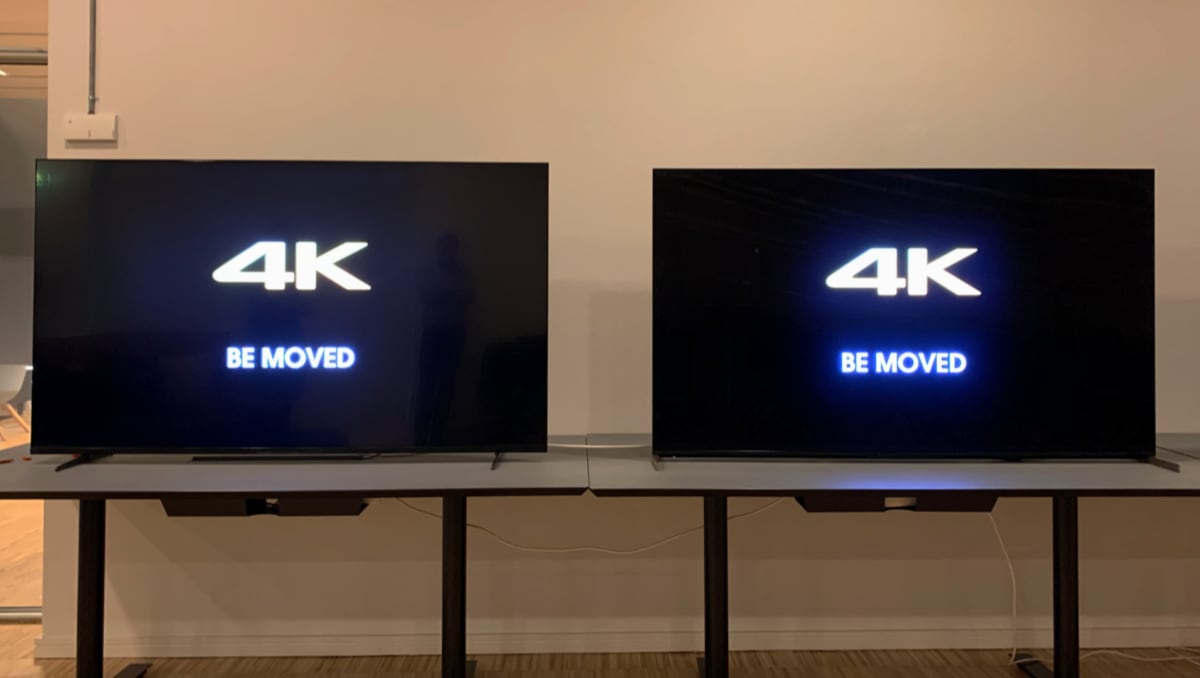Sony is not announcing new TVs at CES 2024 but the company gave FlatpanelsHD a unique preview of its next-generation miniLED technology planned for an upcoming flagship LCD TV.Update: Article has been updated with two videos, shot by FlatpanelsHD, of Sony's new miniLED LCD technology.
With TCL moving to 5000 miniLED dimming zones in its latest LCD TVs, Sony is gearing up to counter with upgraded miniLED LCD technology aimed at improving picture quality and reducing power consumption. During an event last year in Tokyo, Japan, attended by FlatpanelsHD, Sony's display engineers showcased and discussed the technology for the first time. Unfortunately, we are not yet able to share information on the actual product or sizes. However, we can share some video of the new technology, information and thoughts ahead of the official announcement. While Sony did not specifically say that it is coming in 2024, there were enough indications that we fully expect it to happen this year.Sony's next-gen miniLED LCD tech
Sony's display engineers argued that effective local dimming, miniLED or otherwise, in an LCD TV is primarily determined by 3 components:Sony believes it masters these disciplines better than any other, even if its LCD TVs do not always have the highest number of dimming zones among TV makers. In 2024, Sony will transition to a new 22-bit miniLED driver (10-bit current + 12-bit PWM, while the LCD panel remains 10-bit). The company claims that this driver is the world's smallest, enabling the incorporation of more dimming zones. The 2024 miniLED LCD TV will feature more dimming zones and while Sony is not disclosing the exact number of zones, it did say that each TV size will have more zones than the equivalent Z9D/ZD9, which significantly raised the standard for local dimming back in 2016. Of course, there have been advancements in the field since then.
- The TV processor, responsible for dividing the input signal into LCD and LED backlight data (sometimes referred to as the "dimming algorithm").
- The driver, tasked with converting the LED backlight data into analog signals.
- The (mini)LED backlight, which transforms the electrical signal into visible light (then regulated for light/color levels by the LCD panel).
Sony's 2024 miniLED LCD technology revealed. Read on. Photo: FlatpanelsHD
Sony compared its 2024 prototype to last year's X95L miniLED LCD model, saying that the 2024 model is 1.5x brighter as of the Tokyo demo but the final result will depend on tweaks. Despite this, overall power consumption is reduced by 10-15%, and in Eco mode there is a 30% reduction (2023's X95L is rated as G on EU's energy label, but Sony aims for a better energy class this year). This efficiency improvements are attributed to the new LED driver, which regulates the miniLED zones for every picture frame. As for the official name of the 2024 flagship TV, it is anyone's guess at this point (perhaps Z95M? Or X95M?).Two demonstrations
In Tokyo, Sony had two demonstrations of its 2024 miniLED LCD technology. The first demo had one half of the LCD panel removed, revealing the effect of the miniLED zone dimming backlight on the exposed section – something Sony had never publicly demonstrated before. We were not allowed to film this part of the demo. In this first demo, Sony's 2024 TV was compared to one of Samsung's flagship miniLED LCD models ("Neo QLED") – also with one half of the LCD panel removed – and a significant difference was observed in bright scenes. While the majority of Samsung's miniLED dimming zones were running at full steam in this very bright scene, Sony's miniLED zones carefully and gradually intensified and dimmed in sync with the picture content, which should translate to better light control in the picture you see at home.
Sony X95K de 2022 (derecha). Florecer alrededor de objetos brillantes es una de las desventajas de la atenuación del área del miniLED. La floración se puede reducir aumentando el número de zonas. Imagen: paneles planos HD
En la segunda demostración, se compara el televisor Sony 2024 con el Sony X95L (LCD miniLED 2023) y el Sony A80L (WOLED 2023). Durante parte de la demostración, los dos primeros solo mostraron los efectos de atenuación del área miniLED (sin mostrar una imagen del panel LCD), mientras que el televisor OLED mostró el contenido real como referencia. En otras palabras, vimos múltiples zonas miniLED en un aislamiento atenuado y mejorado. Aquí, la mayor resolución del sistema miniLED en el modelo 2024 y por primera vez en un sistema de atenuación de zona sin procesar nos permitió distinguir algunos detalles de luminancia de la imagen real (mostrada en un televisor OLED como referencia) debido al mayor número de zonas. Por ejemplo, el logotipo de Sony centrado en blanco brillante sobre un fondo negro simplemente apareció como un punto blanco en el X95L 2023, pero era bastante legible cuando se veía con el área miniLED inicial del modelo 2024 atenuada (el televisor está centrado en el video). Imagine un televisor LCD con, por ejemplo, 3.000 zonas de atenuación. En este ejemplo, la resolución de la retroiluminación miniLED será de alrededor de 40x74 (= 2960 áreas), que es mucho menor que la resolución del panel LCD 4K (3840x2160 = 8294400) frente a él, pero lo suficientemente alta como para reproducir al menos algunas detalle de luminancia en su forma original y ayuda a reducir los florecimientos (o halos) en la imagen real que ves. Mire los dos vídeos de demostración que FlatpanelsHD filmó durante la demostración en Tokio:Izquierda: Sony X95L (2023) que muestra la atenuación del área miniLED. Centro: La tecnología LCD miniLED 2024 (prototipo) muestra su área de atenuación miniLED. Derecha: Sony A80L OLED muestra el contenido de la imagen como referencia. Vídeo: paneles planos HD
2024 La tecnología LCD MiniLED de Sony (prototipo) muestra atenuación de su área miniLED en la mitad de la pantalla. Vídeo: paneles planos HD
En otra parte de la demostración, analizamos contenido de imágenes reales, particularmente escenas brillantes o escenas HDR de alto contraste, que se muestran en los tres televisores. El prototipo de 2024 ofreció una imagen notablemente mejorada con respecto al X95L de 2023 y superó al OLED A80L en escenas muy brillantes. Lea también: Expuesto: Cómo funciona la retroiluminación miniLED de 5000 zonas (TCL X955)También vimos el impacto en el consumo de energía, demostrado por el medidor de potencia adjunto a cada uno de los tres televisores Sony. Esto se hizo en parte para revelar que el menor consumo de energía del modelo 2024 no afectó la efectividad de la retroiluminación miniLED. Por cierto, si Sony hace este corte, anunciará una característica relacionada muy interesante en 2024.Un gran salto para las pequeñas pantallas LCD de Sony
Las demostraciones se centraron en los avances en la atenuación del área miniLED, lo que dificulta la evaluación de la calidad de la imagen final con contenido mixto. Sin embargo, nuestros comentarios durante la demostración relativamente corta fueron prometedores, lo que indica un gran avance para las pantallas LCD MiniLED de Sony. Sin embargo, no estamos convencidos de que esta tecnología incline la balanza de potencia o se acerque al rendimiento de los mejores televisores OLED del mercado, como el Sony A95L QD-OLED. Lea también: Revisión: Sony A95L (QD-OLED)FlatpanelsHD tendrá más tarde la oportunidad de ver el producto final y brindar todos los detalles sobre el nuevo televisor que esperamos sea un modelo insignia para el LCD miniLED de Sony 2024, mientras que el A95L QD-OLED del año pasado se trasladará a 2024.

«Explorador amigable con los hipster. Fanático del café galardonado. Analista. Solucionador de problemas. Alborotador».








More Stories
Microsoft dice que Call of Duty: Black Ops 6 establece un récord en la cantidad de “adiciones de suscriptores de Game Pass el día del lanzamiento”.
Las descargas de Call of Duty: Black Ops 6 maximizan su uso de Internet
Nada hace que el teléfono brille en la oscuridad